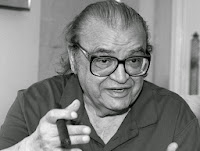A sapphire anniversary
Sunday was the fifth anniversary of this Commonplace Blog. My very first post, appropriately enough given my sworn allegiance to him, was a review of Philip Roth. Few people read it, although I was happy and relieved to publish it here.
The fall of 2008—I was on sabbatical from Texas A&M University, Hurricane Ike wiped out much of the semester, and all of my interest in my current research came down with the power lines. I had begun a book that I was calling Battle Cry of Theory, a history of French theory’s invasion of English departments from the early ’seventies to the present. But as I felt my time slipping away—I’d been diagnosed with terminal cancer just one year before—suddenly I did not relish the thought of spending my last months over the pages of Paul De Man, Jonathan Culler, J. Hillis Miller, Geoffrey Hartman, and the camp followers of the “Yale critics.”
Or perhaps it was merely that, when my family escaped Houston for a few days at a Jewish youth camp in the Hill Country, it did not occur to me to take any theory along for the ride. Instead I immersed myself in Roth’s new novel Indignation, and having finished it much too quickly, borrowed my wife’s copy of The Brass Verdict by the crime novelist Michael Connelly. Back-to-back reviews to commence my career as a book blogger.
I’d been writing book reviews professionally—that is, for low pay—since 1981, when I reviewed Philip Appleman’s Shame the Devil for New York Newsday. Within two years I had attracted the notice of Mel Watkins, the editor of the New York Times Book Review, who put me to work writing short assessments of the novelists that more prominent critics wanted nothing to do with—Katherine Govier (my first), Sheila Bosworth (my first jacket blurb), Whitney Strieber, Jack Higgins, James Alexander Thom, Ernest K. Gann. When Mr Watkins left the Book Review in 1985 (I could never bring myself to call him “Mel”), the new editor quietly dropped me as a regular contributor.
For the next two decades I reviewed little fiction. My PhD was in the history of criticism, especially the history of American criticism, and The Elephants Teach, my first book, was intended as a contribution to that subject.
My original intent, when I had gone off to Northwestern University, was to write a biographical and critical study of the writers grouped around Yvor Winters—his wife Janet Lewis, his best and most famous student J. V. Cunningham, and writers largely forgotten and not typically associated with him, including John Williams, the author of Stoner. I wanted to bring some attention to obscure poets of moving perfection—Helen Pinkerton, for example—and I planned to call my book Peers of Tradition. The phrase was Cunningham’s. The idea was what set these writers apart.
But though Gerald Graff, my PhD advisor, had himself studied under Winters at Stanford, he vetoed my project. Jerry was working on the book that would become Professing Literature, the first history of English departments in America, and I was enlisted to assist him on the research. He suggested that I write a sort of companion volume. Thus was my story of creative writing workshops, in print for seventeen years now, first conceived.
Until I started A Commonplace Blog five years ago, I didn’t fully realize how gaunt and unhealthy-looking my prose had become under the influence of academic writing. The blog format proved unexpectedly congenial. I had no inkling, when I blindly began, that blogging would be so liberating. Not only was I freed from begging letters to editors (if I wanted to review a book, I could review it without anyone’s permission). But also I no longer had to worry about what the chairman of the English department referred to as “career logic,” wherein every printed word must contribute to the building of a limited but national reputation.
Other than the stray political or scandal-mongering post, which always accumulates more “hits,” my five most popular literary essays of the past five years have been these:
(1.) Review of Tim Winton’s novel Breath, probably because the novel’s subject (surfing) causes my review to pop up in search engines.
(2.) My lament “What Became of Literary History?” which mourns the success of New Criticism in reducing the study of literature to “close reading.”
(3.) “Darlings of Oblivion”—a reflection on cancer and the small struggles of daily living, inspired by a phrase from Nabokov.
(4.) My most popular list—“The 10 Worst Prize-Winning American Novels of All Time.” From Jerzy Kosinski to John Updike.
(5.) A reconsideration of Vladimir Jabotinsky’s Samson, a novel that is hard to find, despite Ruth R. Wisse’s inclusion of it in The Modern Jewish Canon. My essay on it is one of the few in “print.”
That two of the five are reviews or review-essays is oddly cheering. Book pages may be dying (and they never gave their reviewers enough space or pay to begin with), and reader reviews may be squeezing out professional reviewers, but I remain convinced that readers are starved for intelligent and serious book-talk. I am proud to have contributed my share over the past five years.







